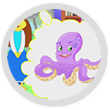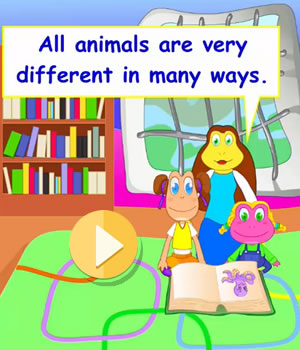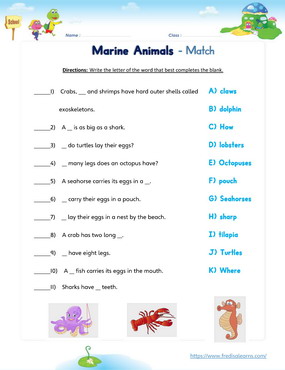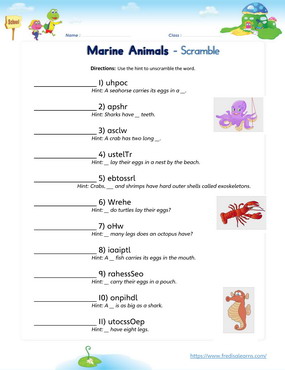Unit 3: Marine Animals
Objectives:
- Learn the names of animals that live in the sea and some of their unique characteristics with the help of this ESL kids lesson.
- Spark curiosity in the lives of sea animals and teach essential English vocabulary and phrases for talking about their unusual lifestyles.
- To learn to ask and give descriptions of sea animals.
Main Lesson Materials & Study Steps
1st –This cartoon animated video features a short dialogue, followed by vocabulary and sentence breakdown. It is essential for introducing the words, phrases, grammar, spelling and sentences of the lesson in context. Watch repeatedly to master the content. The video plays on any device.
2nd – Then the student plays this fun game after watching the video, to practice the contents of the lesson. The game reviews key vocabulary, grammar and sentences from the lessons. This game can be played on any device.
3rd – Finally the learner takes this test of the unit. The score of this test is captured in the LMS and gives educators an idea of how well their learner is doing. The test opens on any device – mobile & PC.
Worksheets for the Unit
The worksheets below are useful for offline and classroom activities. These printable exercises directly correlate with the above lesson 'Marine Animals'. Every worksheet comes with an answer sheet on the second page for educators.
Already a Member?
Not a member yet?
Lesson Story:
Lisa and Sally are in the school library reading about marine animals. Lisa is particularly surprised to learn that seahorses are cared for by their dads and not moms. The two girls also learn that the tilapia fish carries its eggs in the mouth and that turtles lay their eggs in nests like birds. Miss Ann arrives in time to teach them more about other sea animals. Lisa is saddened by the fact that the mother octopus dies after delivering her baby.
Vocabulary:
Sea animal vocabulary
| seahorse |
| crab |
| dolphin |
| shark |
| seal |
| turtle |
| octopus |
| lobster |
| whale |
| shrimp |
| tilapia fish |
Other words
| eggs |
| pouch |
| nest |
| legs |
| birds |
| sea (marine) |
Animal features
| seahorses | carry eggs in dad's pouch |
| octopuses | have eight legs |
| sharks | have sharp teeth |
| crabs | have two long claws |
| turtles | lay eggs in nests |
| tilapia fish | carry eggs in their mouth |
Key Sentences:
Asking about marine animals
| 1. Where do seahorses carry their eggs? |
| 2. Seahorses carry their eggs in a pouch. |
| 3. How many legs do octopuses have? |
| 4. Octopuses have eight legs. |
| 5. What do sharks look like? |
| 6. They have sharp teeth. |
| 7. Where do turtles lay their eggs? |
| 8. Turtles lay their eggs in nests. |
Dialogue Script
Sally: Lisa, what is your book about?
Lisa: It’s about marine animals. Do you want to read it with me?
Sally: Yes, I do.
Lisa: The book says seahorses carry their eggs in their dad’s pouch.
Sally: Not their moms?
Lisa: No, their dad’s.
Sally: That is very strange!
Sally: Look, Lisa! Turtles lay their eggs in nests.
Lisa: Are turtles birds?
Sally: No, they are marine animals!
Lisa: What are marine animals?
Sally: Marine animals are animals that live in the sea.
Lisa: It’s silly that turtles have nests. That’s what birds do!
Sally: I know. But so do turtles.
Sally: Look, this is a tilapia fish.
Lisa: What does the tilapia fish do?
Sally: It carries its eggs in its mouth.
Ms. Ann: What are you reading?
Lisa: We are reading about marine animals!
Ms. Ann: That is wonderful!
Sally: Ms. Ann, seahorses are cared for by their dads.
Ms. Ann: That is very interesting, Sally.
Sally: Who cares for baby octopuses?
Lisa: Most fish don’t even have legs!
Ms. Ann: All animals are very different in many ways.
This lesson is part of the Level 5 English course.
Are you interested in the world of marine animals? Do you want to learn more about the different creatures that live in the sea? This ESL kids lesson is just for you! In this unit, you will learn the names of various sea animals and their unique characteristics.
From the gigantic blue whale to the tiny seahorse, you will discover the fascinating lives of these animals and learn essential English vocabulary and phrases to describe them. You will also learn how to ask and give descriptions of sea animals, enabling you to communicate your knowledge to others.
This lesson aims to spark your curiosity in the marine world and encourage you to learn more about these incredible creatures. You will be able to discuss their unusual lifestyles and share your knowledge with your friends and family.
By the end of this unit, you will have expanded your English vocabulary and learned more about the incredible animals that call the sea their home. So, let's dive in and explore the wonders of the ocean together!














